Seniors in the Mechanical Engineering program met in Rougeou Hall on Friday, May 3, to present their student projects to a faculty review panel, including Dr. Will Emblom, Dr. Chris Dalton, and Dr. Sally Anne McInerny, Head of the MCHE Department, and their peers.
The presentations highlighted the technical challenges and issues that mechanical engineers face in their careers, while allowing students to display their ability to apply the knowledge they’ve gained in the classroom to practical, “real life” scenarios.
Projects ranged from the long-running , formerly known as the Mini Baja, to the 91ÖĆƬł§ÔÚĎ߹ۿ´ of Louisiana at Lafayette’s inaugural foray into the vehicle challenge, with solutions for two government-related challenges and a prototype of a practical, cost-effective electric generator tester in-between.
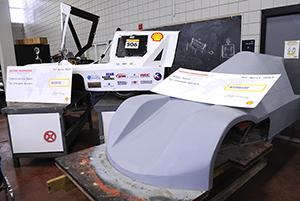 The Shell Eco-marathon challenges student teams from around the world to design, build and test ultra energy-efficient vehicles—pushing to see just how many miles can be squeezed out of one gallon of fuel. The “UL Eco” team, led by Clint Manuel and David Stelly, worked over the last two semesters to create an entry for the “roadworthy” UrbanConcept category. Their vehicle came in third for fuel efficiency at the Houston event on April 4-7, running for 375 miles, and took first place in design and communication categories.
The Shell Eco-marathon challenges student teams from around the world to design, build and test ultra energy-efficient vehicles—pushing to see just how many miles can be squeezed out of one gallon of fuel. The “UL Eco” team, led by Clint Manuel and David Stelly, worked over the last two semesters to create an entry for the “roadworthy” UrbanConcept category. Their vehicle came in third for fuel efficiency at the Houston event on April 4-7, running for 375 miles, and took first place in design and communication categories.
The team created a design to maximize fuel-efficiency and built the body using aluminum and lightweight fiberglass mold production techniques. The team’s media promotions of the car included a that documented the project, a for advertisers, and interviews on local television stations and Fox.
Each first place award carried a $2,000 prize. The $4,000 brought the total amount raised for the project to $18,000, which was just enough to cover the team members’ expenses.
Jonathan Dupuis led a group of three in a parametric experimental study for the purpose of optimizing the liters per minute delivered by a small pump used for air quality sampling.
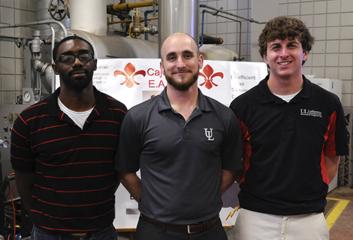 Derek Dupuis and co-leader Matthew Conques led a five-person team on the Upward Falling Payload Project. They spent a semester creating a device solicited by the Strategic Technology Office through the Defense Advanced Research Projects Agency ().
Derek Dupuis and co-leader Matthew Conques led a five-person team on the Upward Falling Payload Project. They spent a semester creating a device solicited by the Strategic Technology Office through the Defense Advanced Research Projects Agency ().
They conducted intensive research to develop a “pod” that is capable of being stationed on the sea floor for long periods of time and then activated to rise and release its contents on command. The pod was required to withstand 9,000 pounds per square inch of pressure underwater, contain a payload up to three feet in length, and a communications system capable of activating the pod.
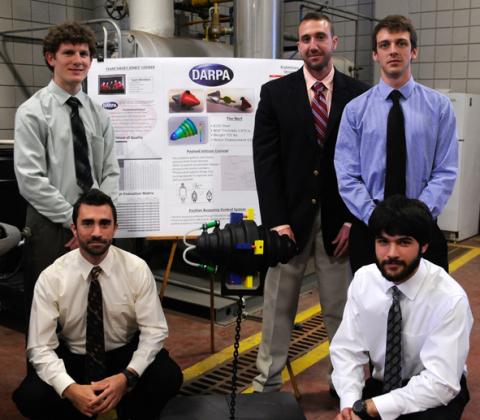 Since 1958, DARPA has solicited the public’s help to develop innovative technologies that solve practical problems through applied research with the goal of maintaining the technological superiority of the U.S. military. The students noted that the Upward Falling Payload Project could be used for military or humanitarian purposes, giving the example “if the pods contained a small drone with surveillance equipment, they could be released and activated in the aftermath of a tsunami to help scan the ocean for survivors.”
Since 1958, DARPA has solicited the public’s help to develop innovative technologies that solve practical problems through applied research with the goal of maintaining the technological superiority of the U.S. military. The students noted that the Upward Falling Payload Project could be used for military or humanitarian purposes, giving the example “if the pods contained a small drone with surveillance equipment, they could be released and activated in the aftermath of a tsunami to help scan the ocean for survivors.”
The team’s goal of creating a pod that could deliver its contents in the most efficient, reliable, cost-effective manner led their research and choices of shapes, materials, and electronics systems. They intend to continue working on the project’s documentation until the proposal for DARPA is complete.
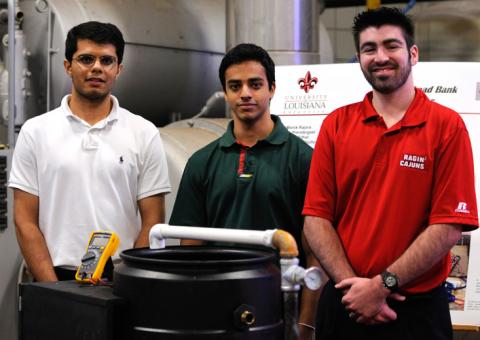 In a presentation marked by humorous descriptions of the failures that preceded the successes during the team’s research phase, team leader Manik Rajora and two teammates talked about their Resistive Load Bank Project. The load bank was created to dissipate electrical loads as quickly and efficiently as possible, with the least environmental impact. Devices of this nature are used to test the electrical output of generators, which are vital in hurricane-prone areas such as southern Louisiana. Their solution provided a cost-effective, space-conscious, portable, and easily duplicated device that is capable of dissipating up to 11.5 kilowatts of electricity at 240 volts.
In a presentation marked by humorous descriptions of the failures that preceded the successes during the team’s research phase, team leader Manik Rajora and two teammates talked about their Resistive Load Bank Project. The load bank was created to dissipate electrical loads as quickly and efficiently as possible, with the least environmental impact. Devices of this nature are used to test the electrical output of generators, which are vital in hurricane-prone areas such as southern Louisiana. Their solution provided a cost-effective, space-conscious, portable, and easily duplicated device that is capable of dissipating up to 11.5 kilowatts of electricity at 240 volts.
The project group, known as the Cajun Motor Sports team and led by Kyle Hollier, presented the research they’ve completed to redesign and improve almost every aspect of the 91ÖĆƬł§ÔÚĎ߹ۿ´â€™s entry. The team will continue their work over the next two semesters as they ready for the 2014 SAE Baja Challenge, continuing UL Lafayette’s long-standing tradition of participating in the event.
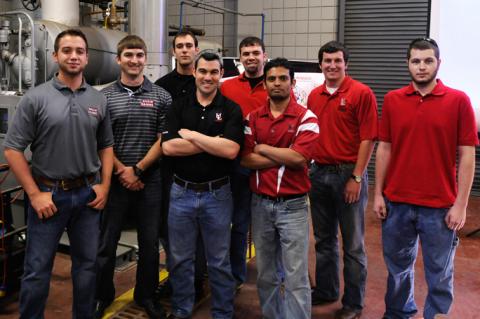 The 91ÖĆƬł§ÔÚĎ߹ۿ´â€™s history with the Baja SAE Series goes all the way back to the beginning, when we were one of 10 teams competing in the competition in 1976. The 91ÖĆƬł§ÔÚĎ߹ۿ´, then known as USL, hosted the second Mini Baja competition in 1977. The relationship was further cemented when the founder of the competition, Dr. John Stevens, formerly a professor at South Carolina, came to serve as Department head for the Mechanical Engineering Department at USL. We have competed nearly every year since.
The 91ÖĆƬł§ÔÚĎ߹ۿ´â€™s history with the Baja SAE Series goes all the way back to the beginning, when we were one of 10 teams competing in the competition in 1976. The 91ÖĆƬł§ÔÚĎ߹ۿ´, then known as USL, hosted the second Mini Baja competition in 1977. The relationship was further cemented when the founder of the competition, Dr. John Stevens, formerly a professor at South Carolina, came to serve as Department head for the Mechanical Engineering Department at USL. We have competed nearly every year since.
Congratulations to all the Mechanical Engineering seniors on a job well done and good luck to the rising seniors who will continue working on the Shell Eco-Marathon and SAE Baja projects next year! To see photos of the students and their presentations, please see our photo gallery on .
